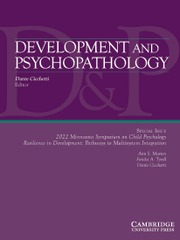Crossref Citations
This article has been cited by the following publications. This list is generated based on data provided by
Crossref.
Dumas, Jean E.
Prinz, Ronald J.
Smith, Emilie Phillips
and
Laughlin, James
1999.
The EARLY ALLIANCE Prevention Trial: An Integrated Set of Interventions to Promote Competence and Reduce Risk for Conduct Disorder, Substance Abuse, and School Failure.
Clinical Child and Family Psychology Review,
Vol. 2,
Issue. 1,
p.
37.
Farmer, Thomas W.
Farmer, Elizabeth M.Z.
and
Gut, Dianne M.
1999.
Implications of Social Development Research for School-Based Interventions for Aggressive Youth with EBD.
Journal of Emotional and Behavioral Disorders,
Vol. 7,
Issue. 3,
p.
130.
Patterson, Gerald R.
and
Yoerger, Karen
1999.
Intraindividual growth in covert antisocial behaviour: a necessary precursor to chronic juvenile and adult arrests?.
Criminal Behaviour and Mental Health,
Vol. 9,
Issue. 1,
p.
24.
Lösel, Friedrich
1999.
Forensische Psychiatrie und Psychologie des Kindes- und Jugendalters.
p.
221.
Farmer, Elizabeth M. Z.
and
Farmer, Thomas W.
1999.
The Role of Schools in Outcomes for Youth: Implications for Children's Mental Health Services Research.
Journal of Child and Family Studies,
Vol. 8,
Issue. 4,
p.
377.
FERGUSSON, DAVID M.
HORWOOD, L. JOHN
and
NAGIN, DANIEL S.
2000.
OFFENDING TRAJECTORIES IN A NEW ZEALAND BIRTH COHORT*.
Criminology,
Vol. 38,
Issue. 2,
p.
525.
Wills, Thomas Ashby
Gibbons, Frederick X.
Gerrard, Meg
and
Brody, Gene H.
2000.
Protection and vulnerability processes relevant for early onset of substance use: A test among African American children..
Health Psychology,
Vol. 19,
Issue. 3,
p.
253.
Farmer, Thomas W.
and
Cadwallader, Thomas W.
2000.
Social Interactions and Peer Support for Problem Behavior.
Preventing School Failure: Alternative Education for Children and Youth,
Vol. 44,
Issue. 3,
p.
105.
Maughan, Barbara
Pickles, Andrew
Rowe, Richard
Costello, E. Jane
and
Angold, Adrian
2000.
Developmental Trajectories of Aggressive and Non-Aggressive Conduct Problems.
Journal of Quantitative Criminology,
Vol. 16,
Issue. 2,
p.
199.
Huey, Stanley J.
Henggeler, Scott W.
Brondino, Michael J.
and
Pickrel, Susan G.
2000.
Mechanisms of change in multisystemic therapy: Reducing delinquent behavior through therapist adherence and improved family and peer functioning..
Journal of Consulting and Clinical Psychology,
Vol. 68,
Issue. 3,
p.
451.
Patterson, Gerald R.
Dishion, Thomas J.
and
Yoerger, Karen
2000.
Adolescent Growth in New Forms of Problem Behavior: Macro- and Micro-Peer Dynamics.
Prevention Science,
Vol. 1,
Issue. 1,
p.
3.
Sheldrick, Radley C.
Kendall, Philip C.
and
Heimberg, Richard G.
2001.
The clinical significance of treatments: A comparison of three treatments for conduct disordered children..
Clinical Psychology: Science and Practice,
Vol. 8,
Issue. 4,
p.
418.
Eamon, Mary Keegan
2001.
Poverty, Parenting, Peer, and Neighborhood Influences on Young Adolescent Antisocial Behavior.
Journal of Social Service Research,
Vol. 28,
Issue. 1,
p.
1.
Atkins, Marc S.
and
McKay, Mary M.
2001.
Advanced Abnormal Psychology.
p.
209.
Abell, Melissa L.
Fraser, Mark W.
and
Galinsky, Maeda J.
2001.
Early Intervention for Aggressive Behavior in Childhood: A Pilot Study of a Multi-Component Intervention with Elementary School Children and Their Families.
Journal of Family Social Work,
Vol. 6,
Issue. 4,
p.
19.
Gaziano, Cecilie
2001.
Toward a Broader Conceptual Framework for Research on Social Stratification, Childrearing Patterns, and Media Effects.
Mass Communication and Society,
Vol. 4,
Issue. 2,
p.
201.
JONES, BOBBY L.
NAGIN, DANIEL S.
and
ROEDER, KATHRYN
2001.
A SAS Procedure Based on Mixture Models for Estimating Developmental Trajectories.
Sociological Methods & Research,
Vol. 29,
Issue. 3,
p.
374.
Calhoun, Georgia B.
Glaser, Brian A.
and
Bartolomucci, Christi L.
2001.
The Juvenile Counseling and Assessment Model and Program: A Conceptualization and Intervention for Juvenile Delinquency.
Journal of Counseling & Development,
Vol. 79,
Issue. 2,
p.
131.
Mason, W. Alex
and
Windle, Michael
2001.
Delinquency Risk as a Function of Number of Early Onset Problem Behaviors.
International Journal of Offender Therapy and Comparative Criminology,
Vol. 45,
Issue. 4,
p.
436.
Israel, Allen C.
and
Roderick, Helena A.
2001.
A Measure of the Stability of Family Activities: AN Initial Examination.
Assessment,
Vol. 8,
Issue. 4,
p.
417.

